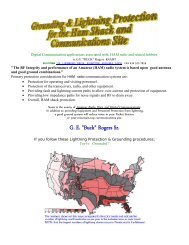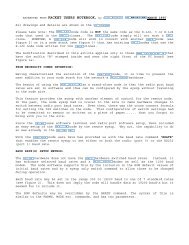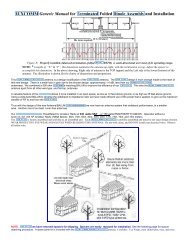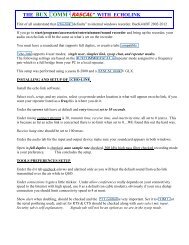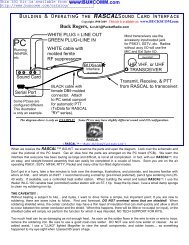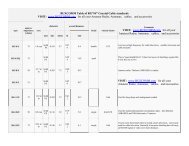A touch of Class, The Windom and the J-POLE
A touch of Class, The Windom and the J-POLE
A touch of Class, The Windom and the J-POLE
You also want an ePaper? Increase the reach of your titles
YUMPU automatically turns print PDFs into web optimized ePapers that Google loves.
For now, let's look at some <strong>of</strong> <strong>the</strong> features <strong>of</strong> our J-Pole, whe<strong>the</strong>r for; 140-150 mHz, or 430-450 mHz<br />
<strong>the</strong> J-Pole is easy to erect<br />
<strong>the</strong> J-Pole needs no radials<br />
<strong>the</strong> J-Pole has low angle radiation<br />
<strong>the</strong> J-<strong>POLE</strong> has greater b<strong>and</strong>width.<br />
<strong>the</strong> J-Pole has greater immunity to terrestrial noise<br />
<strong>the</strong> J-Pole is great for local nets or distant repeaters<br />
<strong>the</strong> J-Pole has more gain than most Ground Planes<br />
<strong>the</strong> J-Pole is more durable than most Ground Planes<br />
<strong>the</strong> J-Pole meets most "stealth" antenna restriction agreements<br />
<strong>the</strong> J-Pole has less static-charge noise, <strong>and</strong> static-charge build-up.<br />
In <strong>the</strong> mid-fifties, <strong>and</strong> early sixties, ridged copper was difficult to find, <strong>and</strong> even if we were fortunate<br />
enough to locate ridged copper, <strong>the</strong> cost was prohibitive. Most <strong>of</strong> our VHF (don't even think about UHF)<br />
operating was AM (for <strong>the</strong> late model HAM, "Amplitude Modulation"), <strong>and</strong> on two meters, operating was<br />
centered around 144 MHz. We ei<strong>the</strong>r opt'd for a bamboo spreader cubical quad, or folded "zepp," as we<br />
called it in those days (now-a-days, called a "J-Pole.")<br />
Ano<strong>the</strong>r variation to this antenna construction was to use electrical thin-wall conduit or "EMT." EMT actually<br />
means "electrical metallic thin-wall" but somehow early acronyms had a way <strong>of</strong> getting turned around, or inverted,<br />
. . . or perverted.. hi.<br />
Using metal EMT instead <strong>of</strong> copper, we learned to use <strong>the</strong> brazing rods <strong>and</strong> torch to fabricate our "folded (zepp) Jay."<br />
In any case, we were able to make <strong>the</strong> J-Pole happen. For VHF, <strong>the</strong> J-Pole became <strong>the</strong> antenna <strong>of</strong> choice,<br />
just as <strong>the</strong> <strong>Windom</strong> took its place as <strong>the</strong> antenna <strong>of</strong> choice for <strong>the</strong> lower (HF) b<strong>and</strong>s. As a matter <strong>of</strong> interest,<br />
look close at both <strong>the</strong> J-pole <strong>and</strong> <strong>the</strong> <strong>Windom</strong>, <strong>and</strong> you might find a close resemblance <strong>and</strong> maybe even some<br />
relationships in <strong>the</strong> <strong>of</strong>f-center method used to feed each <strong>of</strong> <strong>the</strong>m.<br />
I've heard <strong>of</strong> J-poles stacked, collinearized, <strong>and</strong> some with weird fitted, 1955 Ford fender-skirts. Depending on<br />
who's telling <strong>the</strong> story, <strong>the</strong>y might have more gain than a yagi on a helicopter at 1200 feet, or <strong>the</strong>y won't reach a h<strong>and</strong>-held<br />
across <strong>the</strong> backyard. I try to make it a personal point to stay out <strong>of</strong> <strong>the</strong>se CB<br />
University fences. You can put a "mini-skirt" on it, you can even place a "tutu" on<br />
<strong>the</strong> J-Pole, but <strong>the</strong> truth is, it remains a Jpole.<br />
As a personal observation throughout my 64 years as a HAM; Mistakes,<br />
Experience, <strong>and</strong> Knowledge has given this ole HAM <strong>the</strong> Wisdom to know <strong>the</strong><br />
difference. Don't try to build a <strong>Windom</strong> for two meters, <strong>and</strong> for<br />
heavens sake, DO NOT attempt building a J-Pole for seventy-five (75) meters.<br />
As <strong>the</strong>y say, "do <strong>the</strong> math;" Just <strong>the</strong> long, vertical section <strong>of</strong> a 75 meter J-pole<br />
would near 200 feet.<br />
TO THE POINT OF OUR SUBJECT:<br />
I've had many requests for a ready-made J-pole design that will enable <strong>the</strong> Amateur<br />
Radio user to print <strong>the</strong> image from a web page <strong>and</strong> go directly to <strong>the</strong> construction<br />
table <strong>and</strong> build a J-Pole antenna for <strong>the</strong>ir HAM Radio station.<br />
On this page you will find many illustrations I've drawn to help you underst<strong>and</strong> <strong>the</strong><br />
manner in which a J Pole is built.<br />
Fabrication can sometimes be a problem for <strong>the</strong> apartment dweller, or <strong>the</strong> HAM<br />
with limited facilities for this kind <strong>of</strong> project.<br />
For <strong>the</strong>se reasons, you may wish to purchase <strong>the</strong> "direct fed Jpole"<br />
ready to install. We <strong>of</strong>fer this BUXCOMM J POL<br />
in two versions;



